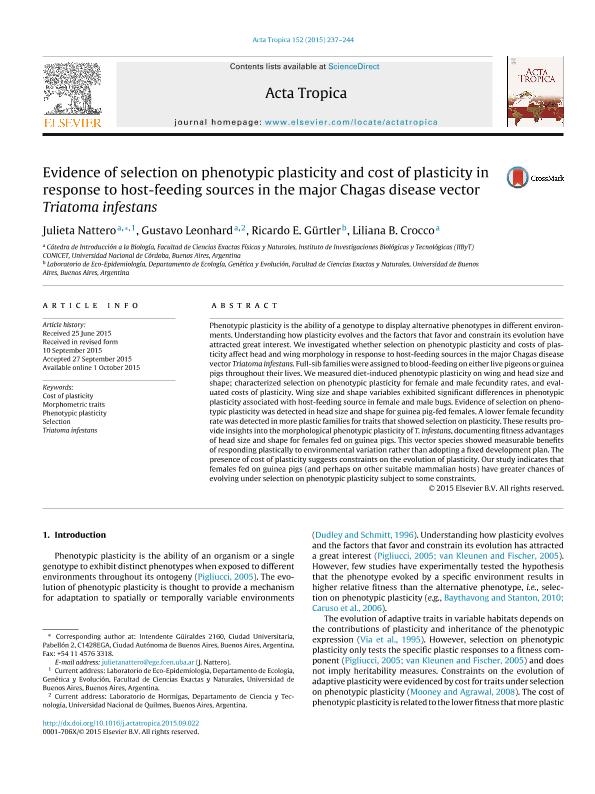Mostrar el registro sencillo del ítem
dc.contributor.author
Nattero, Julieta

dc.contributor.author
Leonhard, Gustavo

dc.contributor.author
Gurtler, Ricardo Esteban

dc.contributor.author
Crocco, Liliana Beatriz

dc.date.available
2018-09-19T19:08:10Z
dc.date.issued
2015-12
dc.identifier.citation
Nattero, Julieta; Leonhard, Gustavo; Gurtler, Ricardo Esteban; Crocco, Liliana Beatriz; Evidence of selection on phenotypic plasticity and cost of plasticity in response to host-feeding sources in the major Chagas disease vector Triatoma infestans; Elsevier Science; Acta Tropica; 152; 12-2015; 237-244
dc.identifier.issn
0001-706X
dc.identifier.uri
http://hdl.handle.net/11336/60284
dc.description.abstract
Phenotypic plasticity is the ability of a genotype to display alternative phenotypes in different environments. Understanding how plasticity evolves and the factors that favor and constrain its evolution have attracted great interest. We investigated whether selection on phenotypic plasticity and costs of plasticity affect head and wing morphology in response to host-feeding sources in the major Chagas disease vector Triatoma infestans. Full-sib families were assigned to blood-feeding on either live pigeons or guinea pigs throughout their lives. We measured diet-induced phenotypic plasticity on wing and head size and shape; characterized selection on phenotypic plasticity for female and male fecundity rates, and evaluated costs of plasticity. Wing size and shape variables exhibited significant differences in phenotypic plasticity associated with host-feeding source in female and male bugs. Evidence of selection on phenotypic plasticity was detected in head size and shape for guinea pig-fed females. A lower female fecundity rate was detected in more plastic families for traits that showed selection on plasticity. These results provide insights into the morphological phenotypic plasticity of T. infestans, documenting fitness advantages of head size and shape for females fed on guinea pigs. This vector species showed measurable benefits of responding plastically to environmental variation rather than adopting a fixed development plan. The presence of cost of plasticity suggests constraints on the evolution of plasticity. Our study indicates that females fed on guinea pigs (and perhaps on other suitable mammalian hosts) have greater chances of evolving under selection on phenotypic plasticity subject to some constraints.
dc.format
application/pdf
dc.language.iso
eng
dc.publisher
Elsevier Science

dc.rights
info:eu-repo/semantics/openAccess
dc.rights.uri
https://creativecommons.org/licenses/by-nc-nd/2.5/ar/
dc.subject
Cost of Plasticity
dc.subject
Morphometric Traits
dc.subject
Phenotypic Plasticity
dc.subject
Selection
dc.subject
Triatoma Infestans
dc.subject.classification
Otras Ciencias Biológicas

dc.subject.classification
Ciencias Biológicas

dc.subject.classification
CIENCIAS NATURALES Y EXACTAS

dc.title
Evidence of selection on phenotypic plasticity and cost of plasticity in response to host-feeding sources in the major Chagas disease vector Triatoma infestans
dc.type
info:eu-repo/semantics/article
dc.type
info:ar-repo/semantics/artículo
dc.type
info:eu-repo/semantics/publishedVersion
dc.date.updated
2018-09-19T14:33:57Z
dc.journal.volume
152
dc.journal.pagination
237-244
dc.journal.pais
Países Bajos

dc.journal.ciudad
Amsterdam
dc.description.fil
Fil: Nattero, Julieta. Consejo Nacional de Investigaciones Científicas y Técnicas. Oficina de Coordinación Administrativa Ciudad Universitaria. Instituto de Ecología, Genética y Evolución de Buenos Aires. Universidad de Buenos Aires. Facultad de Ciencias Exactas y Naturales. Instituto de Ecología, Genética y Evolución de Buenos Aires; Argentina
dc.description.fil
Fil: Leonhard, Gustavo. Consejo Nacional de Investigaciones Científicas y Técnicas. Centro Científico Tecnológico Conicet - Córdoba. Instituto de Investigaciones Biológicas y Tecnológicas. Universidad Nacional de Córdoba. Facultad de Ciencias Exactas, Físicas y Naturales. Instituto de Investigaciones Biológicas y Tecnológicas; Argentina
dc.description.fil
Fil: Gurtler, Ricardo Esteban. Consejo Nacional de Investigaciones Científicas y Técnicas. Oficina de Coordinación Administrativa Ciudad Universitaria. Instituto de Ecología, Genética y Evolución de Buenos Aires. Universidad de Buenos Aires. Facultad de Ciencias Exactas y Naturales. Instituto de Ecología, Genética y Evolución de Buenos Aires; Argentina
dc.description.fil
Fil: Crocco, Liliana Beatriz. Consejo Nacional de Investigaciones Científicas y Técnicas. Centro Científico Tecnológico Conicet - Córdoba. Instituto de Investigaciones Biológicas y Tecnológicas. Universidad Nacional de Córdoba. Facultad de Ciencias Exactas, Físicas y Naturales. Instituto de Investigaciones Biológicas y Tecnológicas; Argentina
dc.journal.title
Acta Tropica

dc.relation.alternativeid
info:eu-repo/semantics/altIdentifier/doi/http://dx.doi.org/10.1016/j.actatropica.2015.09.022
dc.relation.alternativeid
info:eu-repo/semantics/altIdentifier/url/https://www.sciencedirect.com/science/article/pii/S0001706X15301200
Archivos asociados
